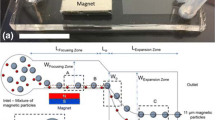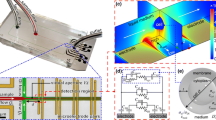Abstract
This study presents a sheathless and portable microfluidic chip that is capable of high-throughput focusing bioparticles based on 3D travelling-wave dielectrophoresis (twDEP). High-throughput focusing is achieved by sustaining a centralized twDEP field normal to the continuous through-flow direction. Two twDEP electrode arrays are formed from upper and lower walls of the microchannel and extend to its center, which induce twDEP forces to provide the lateral displacements in two directions for focusing the bioparticles. Bioparticles can be focused to the center of the microchannel effectively by twDEP conveyance when the characteristic time due to twDEP conveying in the y direction is shorter than the residence time of the particles within twDEP electrode array. Red blood cells can be effectively focused into a narrow particle stream (~10 μm) below a critical flow rate of 10 μl/min (linear flow velocity ~5 mm/s), when under a voltage of 14 Vp–p at a frequency of 500 kHz is applied. Approximately 90% focusing efficiency for red blood cells can be achieved within two 6-mm-long electrode arrays when the flow rate is below 12 μl/min. Blood cells and Candida cells were also focused and sorted successfully based on their different twDEP mobilities. Compared to conventional 3D-paired DEP focusing, velocity is enhanced nearly four folds of magnitude. 3D twDEP provides the lateral displacements of particles and long residence time for migrating particles in a high-speed continuous flow, which breaks through the limitation of many electrokinetic cell manipulation techniques.







Similar content being viewed by others
References
Barrett LM, Skulan AJ, Singh AK, Cummings EB, Fiechtner GJ (2005) Dielectrophoretic manipulation of particles and cells using insulating ridges in faceted prism microchannels. Anal Chem 2005(77):6798–6804
Brown M, Wittwer C (2000) Flow cytometry: principles and clinical applications in hematology. Clin Chem 46:1221–1229
Bunthawin S, Wanichapichart P, Tuantranont A, Coster HGL (2010) Dielectrophoretic spectra of translational velocity and critical frequency for a spheroid in traveling electric field. Biomicrofluidics 4:014102
Chen YC, Chang SC, Sun CC, Yang LS, Hsieh WC, Luh KT (1997) Secular trends in the epidemiology of nosocomial fungal infections at a teaching hospital in Taiwan, 1981 to 1993. Infect Control Hosp Epidemiol 18:369–375
Cheng IF, Chang HC, Hou D, Chang HC (2007) An integrated dielectrophoretic chip for continuous bioparticle filtering, focusing, sorting, trapping, and detecting. Biomicrofluidics 1:021503
Cheng IF, Froude VE, Zhu YX, Chang HC, Chang HC (2009) A continuous high-throughput bioparticle sorter based on 3D traveling-wave dielectrophoresis. Lab Chip 9:3193–3201
Cheng IF, Senapati S, Cheng X, Basuray S, Chang HC, Chang HC (2010) A rapid field-use assay for mismatch number and location of hybridized DNAs. Lab Chip 10:828–831
Choi S, Song S, Choi C, Park JK (2008) Sheathless focusing of microbeads and blood cells based on hydrophoresis. Small 4:634–641
Chu H, Doh I, Cho YH (2009) A three-dimensional (3D) particle focusing channel using the positive dielectrophoresis (pDEP) guided by a dielectric structure between two planar electrodes. Lab chip 9:686–691
Church C, Zhu JJ, Wang GY, Tzeng TRJ, Xuan XC (2009) Electrokinetic focusing and filtration of cells in a serpentine microchannel. Biomicrofluidics 3:44109
Fiedler S, Shirley SG, Schnelle T, Fuhr G (1998) Dielectrophoretic sorting of particles and cells in a microsystem. Anal Chem 70:1909–1915
Fu LM, Tsai CH, Lin CH (2008) A high-discernment microflow cytometer with microweir structure. Electrophoresis 29:1874–1880
Hagedorn R, Fuhr G, Muller T, Gimsa J (1992) Traveling-wave dielectrophoresis of microparticles. Electrophoresis 13:49–54
Han KH, Han SI, Frazier AB (2009) Lateral displacement as a function of particle size using a piecewise curved planar interdigitated electrode array. Lab Chip 9:2958–2964
Holmes D, Morgan H, Green NG (2006) High throughput particle analysis: combining dielectrophoretic particle focusing with confocal optical detection. Biosens Bioelectron 21:1621–1630
Hughes MP, Pethig R, Wang XB (1996) Dielectrophoretic forces on particles in travelling electric fields. J Phys D Appl Phys 29:474–482
Jones TB (1995) Electromechanics of particles. Cambridge University Press, Cambridge, New York
Kang YJ, Li DQ (2009) Electrokinetic motion of particles and cells in microchannels. Microfluid Nanofluid 6:431–460
Lee GB, Chang CC, Huang SB, Yang RJ (2006) Hydrodynamic focusing effect inside rectangular microchannels. J Micromech Microeng 16:1024–1032
Lee MG, Choi S, Park JK (2009) Three-dimensional hydrodynamic focusing with a single sheath flow in a single-layer microfluidic device. Lab Chip 9:3155–3160
Lin CH, Lee GB, Lin YH, Chang GL (2001) A fast prototyping process for fabrication of microfluidic systems on soda-lime glass. J Micromech Microeng 11:726–732
Mao X, Waldeisen JR, Huang TJ (2007) “Microfluidic drifting”—implementing three-dimensional hydrodynamic focusing with a single-layer planar microfluidic device. Lab Chip 7:1260–1262
Morgan H, Izquierdo AG, Bakewell D, Green NG, Ramos A (2001) The dielectrophoretic and travelling wave forces generated by interdigitated electrode arrays: analytical solution using Fourier series. J Phys D Appl Phys 34:1553–1561
Ogata S, Yasukawa T, Matsue T (2001) Dielectrophoretic manipulation of a single chlorella cell with dual-microdisk electrode. Bioelectrochemistry 54:33–37
Pan YJ, Ren CM, Yang RJ (2007) Electrokinetic flow focusing and valveless switching integrated with electrokinetic instability for mixing enhancement. J Micromech Microeng 17:820–827
Pethig R, Talary MS, Lee RS (2003) Enhancing traveling-wave dielectrophoresis with signal superposition. IEEE Eng Med Biol Mag 22:43–50
Rao VS, Kripesh V, Yoon SW, Tay AAO (2006) A thick photoresist process for advanced wafer level packaging applications using JSR THB-151N negative tone UV photoresist. J Micromech Microeng 16:1841–1846
Rodriguez-Trujillo R, Mills CA, Samitier J, Gomila G (2007) Low cost micro-Coulter counter with hydrodynamic focusing. Microfluid Nanofluid 3:171–176
Schrum DP, Culbertson CT, Jacobson SC, Ramsey JM (1999) Microchip flow cytometry using electrokinetic focusing. Anal Chem 71:4173–4177
Shi J, Mao X, Ahmed D, Colletti A, Huang TJ (2008) Focusing microparticles in a microfluidic channel with standing surface acoustic waves (SSAW). Lab Chip 8:221–223
Sun T, Green NG, Morgan H (2008) Analytical solutions for the electric field and dielectrophoretic force in a dielectrophoretic focusing electrode structure. Appl Phys Lett 92:173901
Talary MS, Burt JPH, Tame JA, Pethig R (1996) Electromanipulation and separation of cells using travelling electric fields. J Phys D Appl Phys 29:2198–2203
Tsai CH, Hou HH, Fu LM (2008) An optimal three-dimensional focusing technique for micro-flow cytometers. Microfluid Nanofluid 5:827–836
Wang XB, Huang Y, Becker FF, Gascoyne PRC (1994) A unified theory of dielectrophoresis and travelling wave dielectrophoresis. J Phys D Appl Phys 27:1571–1574
Wang XB, Huang Y, Wang X, Becker FF, Gascoyne PRC (1997) Dielectrophoretic manipulation of cells with spiral electrodes. Biophys J 72:1887–1899
Wang L, Flanagan LA, Jeon NL, Monuki E, Lee AP (2007) Dielectrophoresis switching with vertical sidewall electrodes for microfluidic flow cytometry. Lab Chip 7:1114–1120
Wu J, Ben Y, Chang H-C (2005) Particle detection by electrical impedance spectroscopy with asymmetric-polarization AC electroosmotic trapping. Microfluid Nanofluid 1:161–167
Yu C, Vykoukal J, Vykoukal DM, Schwartz JA, Li S, Gascoyne PRC (2005) A three-dimensional dielectrophoretic particle focusing channel for microcytometry applications. J Microelectromech Syst 14:480–487
Zhu JJ, Tzeng TRJ, Hu GQ, Xuan XC (2009) DC dielectrophoretic focusing of particles in a serpentine microchannel. Microfluid Nanofluid 7:751–756
Acknowledgments
This study was supported by the Multidisciplinary Center of Excellence for Clinical Trial and Research (DOH99-TD-B-111-102), Department of Health, Executive Yuan, Taiwan (DOH99-TD-N-111-010), NCKU Project for Promoting Academic Excellence & Developing World Class Research Centers (R017), the NSC under Grant No. 96-2628-B-006-010 MY3 and NSC 97-2218-E-006-004. We also thank National Nano Device Laboratory and Southern Taiwan Nanotechnology Research Center for supplying microfabrication equipment.
Author information
Authors and Affiliations
Corresponding author
Rights and permissions
About this article
Cite this article
Cheng, IF., Chung, CC. & Chang, HC. High-throughput electrokinetic bioparticle focusing based on a travelling-wave dielectrophoretic field. Microfluid Nanofluid 10, 649–660 (2011). https://doi.org/10.1007/s10404-010-0699-8
Received:
Accepted:
Published:
Issue Date:
DOI: https://doi.org/10.1007/s10404-010-0699-8




